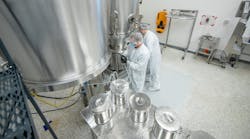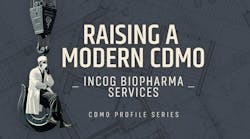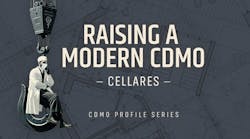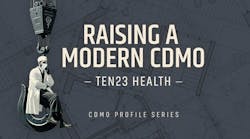Sometimes tackling major challenges requires a major response. In the case of the Center for Breakthrough Medicines (CBM), that has meant building the world’s largest single-site CDMO dedicated to end-to-end development and manufacturing for cell and gene therapies.
In January 2020, the newly formed CBM announced its intention to build a behemoth 680,000-square foot facility inside the 1.6-million square foot Discovery Labs life science campus, a innovation hub dedicated to supporting development and manufacturing of advanced therapies based in King of Prussia, Pennsylvania. In its announcement, the company said that the $1.1 billion undertaking was aimed at addressing the “critical lack of capacity that is preventing patients from accessing critically needed cell and gene therapies.”
While development and demand for cell and gene therapies has blossomed in recent years — EY estimates that there are over 2,600 such therapies in the preclinical and clinical pipelines — production capacity has failed to keep up. The resulting imbalance has led to various bottlenecks, from upstream raw material constraints to long lead times on finished products.
But this is where CBM comes in. Although construction of CBM briefly hit snags once the pandemic gripped the U.S., Audrey Greenberg, co-founder and executive managing director of The Discovery Labs, says the slowdown transformed into a “tremendous effort” to get the facility up and running. As the facility was purchased fully built, Greenberg says that the first phase process development labs inside CBM will come online by the end the first quarter and the first phase GMP suites will be operational during the first quarter of 2022. Once complete, CBM will boast 24 cell therapy suites, 18 viral vector suites, 10 plasma suites, and 40 testing and analytical labs.
“It’s a big footprint,” Greenberg says. “We plan to revolutionize the cell and gene therapy development and manufacturing process inside these walls.”
Solving manufacturing challenges
In addition to addressing the capacity crunch, CBM plans to put everything needed for cell and gene therapies under one roof — from preclinical development through commercial manufacturing. Importantly, Greenberg says that CBM will address supply chain concerns by producing its own raw materials, including plasmid DNA.
“We are going to make our own cGMP plasmid and have excess capacity on hand to avoid supply chain constraints,” Greenberg says.
To make viral vectors, the delivery systems often used for cell and gene therapies, Greenberg says CBM will utilize both adherent and suspension cell lines— two manufacturing modalities that the industry has been working on improving in recent years. CBM’s proprietary technology will also improve downstream purification of vectors to increase yields, which is a common challenge for cell and gene therapy manufacturers.
“Our team has tremendous manufacturing experience. With advancements continuously emerging, we are perfectly positioned to develop and implement process intensification procedures.” Greenberg says. “We offer a platform that maximizes production and recovery. Because it’s great if you can produce a large upstream batch…but downstream recovery is also crucial to determine vector genome yield.”
Greenberg says that CBM is planning to leverage its proprietary technologies for scaling up processes for multiple products, while also partnering with other companies to develop their internal platforms.
“We have a large R&D budget with a team that can create and enhance platforms, and our strategic growth is via collaboration agreements for groundbreaking technology,” Greenberg explains.
Throughout its facility, CBM will also lean on cutting-edge technologies to aid operations including automation, remote monitoring and modular equipment.
“We expect to have highly adaptive network technologies so that we can rapidly reconfigure suites so that any disruptive technology that may change the manufacturing footprint can be easily integrated,” Greenberg explains. “We’re investing upfront to save time and money down the road.”
A patient-focused culture
CBM’s team increased last year from three employees to nearly 20. Now, the hiring push is kicking into high gear with the plan of growing into a team of nearly 250 by the end of 2021. Although Greenberg acknowledges that it’s a “tight labor market,” she says that CBM has thus far been able to hit its hiring targets. The facility’s location near Philadelphia offers a strong selling point — and so does CBM’s mission.
“Prospects are excited about joining a patient-centric company that is looking at increasing affordability and accessibility of these life-saving products,” Greenberg says.
Although Greenberg can’t disclose who CBM’s clients are, she says that the company is working with a number of biotechs developing products that could create a high demand for its services.
“We have an incredibly robust pipeline of customers, any one of which, with commercial success, could take much if not all of our capacity,” she says.
Just what is CBM’s capacity? When dealing with cell and gene therapies, there are a few ways to look at it. Greenberg likes to think about capacity in terms of batches, which can vary depending on the bioreactor volume and how effective upstream and downstream processes are.
“When built-out and fully completed, we estimate that we’ll produce about 300 annual viral vector batches and treat 2,000 cell therapy patients per year,” she says. “The way we can integrate process intensification and the way we can get higher yields will dictate how much we push through in terms of the number of doses.”
But perhaps an even better way to measure capacity, Greenberg says, is in the number of patients impacted by CBM’s work. In that regard, Greenberg says that CBM has set a goal of treating 100 million patients during the lifetime of The Discovery Labs. While CBM has committed to using “out-of-the-box solutions” on a large scale, Greenberg admits that it is still fitting all the pieces in place to deliver on that lofty target.
“Several factors have to come together. There are construction timelines, we have to onboard team members, equipment and consumables are in short supply and there is the regulatory aspect,” she says. “All of that has to come together. Thus far, we have executed according to our ambitious plan of creating a future that provides precision medicine for all.”







